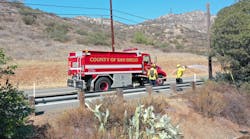Photo by Perimeter Solutions
LTR History
Safety And Protection
Continued Advancement
Utility Use
Community Partnerships
- It prevented any possible ignitions from occurring under or near the lines, even if the ignition came from discarded smoking material, a car hitting the utility pole or hot metal coming off an overheated vehicle.
- It enhanced public/residence evacuations as well as fire personnel and utility vehicle ingress and egress on roads with only one way in and one way out, enabling utility customers to safely evacuate and essential personnel to get into the area in the event of an approaching fire.
Two-Pronged Approach
- They will use it for preventive and proactive application underneath lines and around poles in an enhanced vegetation management situation, eliminating the need to remove vegetation. Utilities already have shown this to be up to 10 times more cost effective and 10 times faster than the mechanical removal of vegetation — if the community they are treating even allows vegetation to be removed. The preventive application also will go around substations, switchyards and high-value infrastructure in the most critical fire-prone areas. This will include areas where roadside ignitions could be likely near utility infrastructure and in support of community wildfire safety programs for effective ingress and egress of community members as well as firefighting and utility vehicles. In the face of red-flag fire warnings, high winds and potential catastrophic weather situations, utilities will start to deploy the preventive application of high-adherence, high-durability LTRs to circuits where it had not been applied at the start of fire season. This could include additional ingress and egress roads and even infrastructure leading into at-risk communities.
- Utilities will start to apply phosphate-based LTRs in a protection manner on and around thousands of poles and infrastructure that models show could be directly in the path of an oncoming wildfire. This will save utilities millions in replacement costs and help communities to restore power faster after the wildfire moves through the community.







